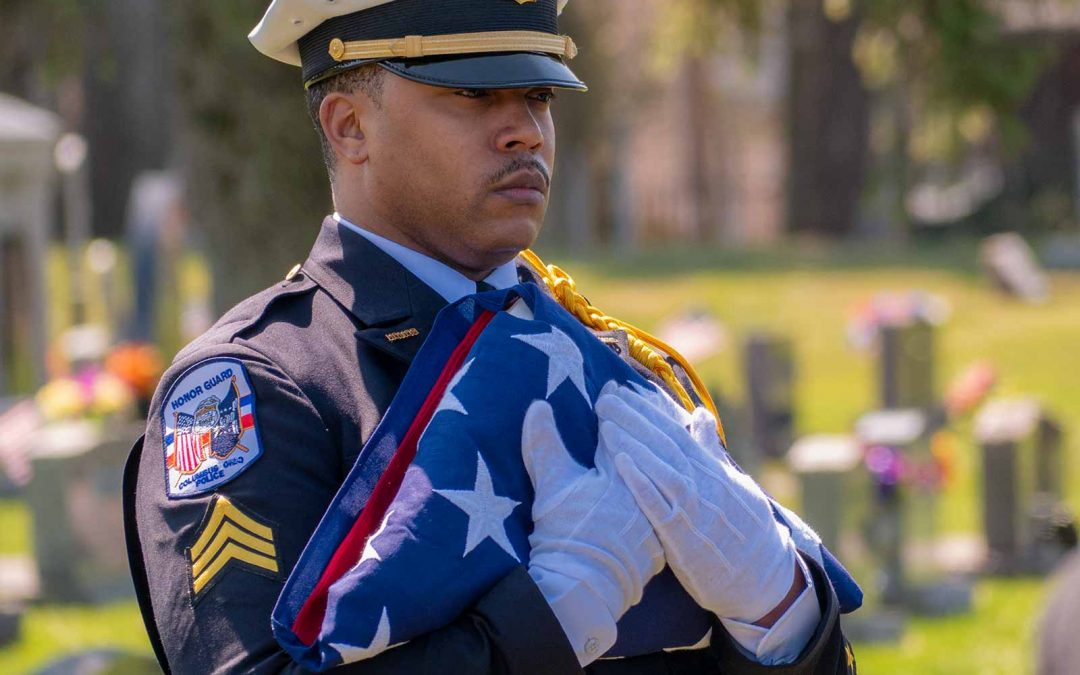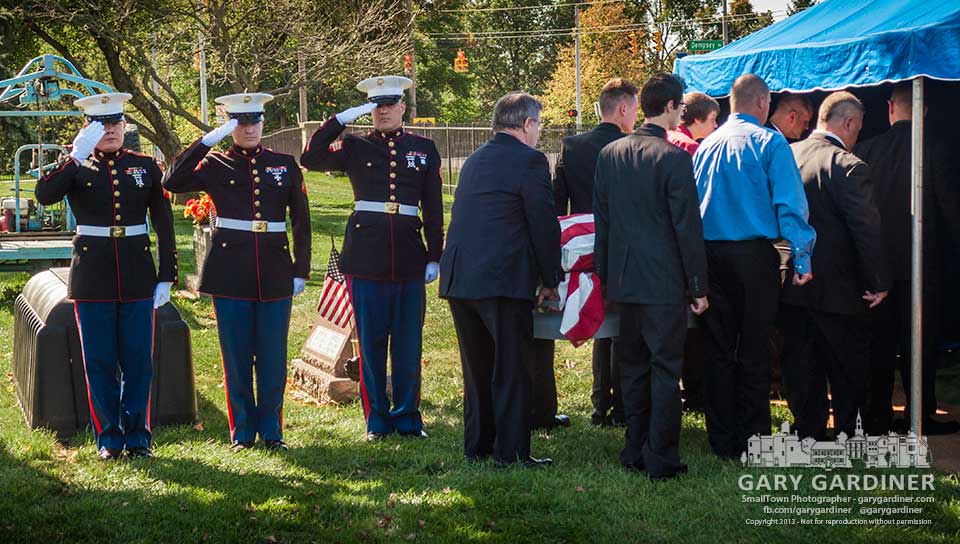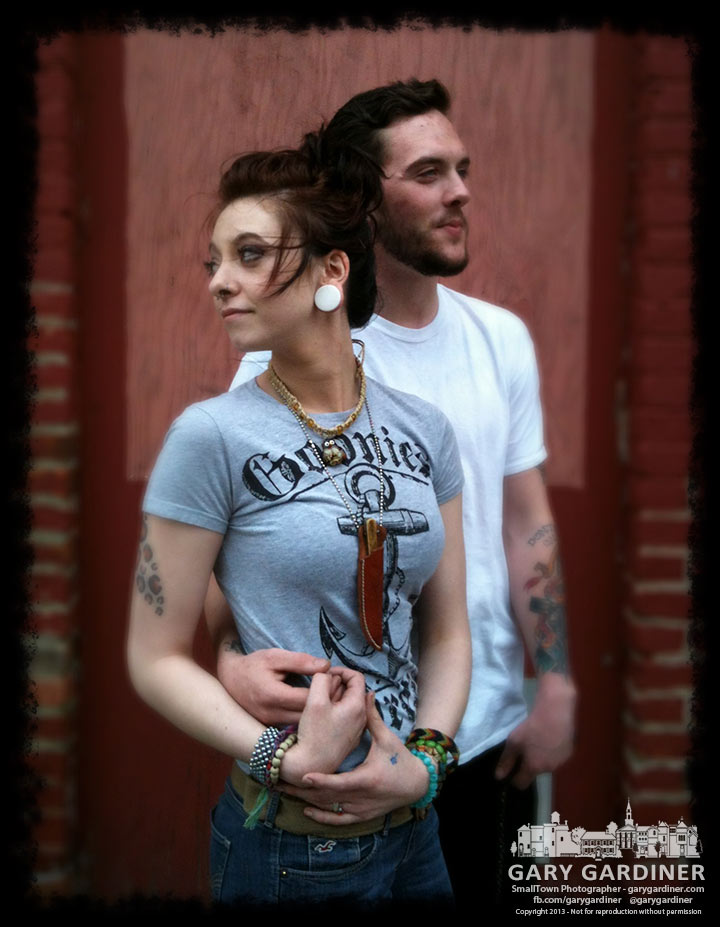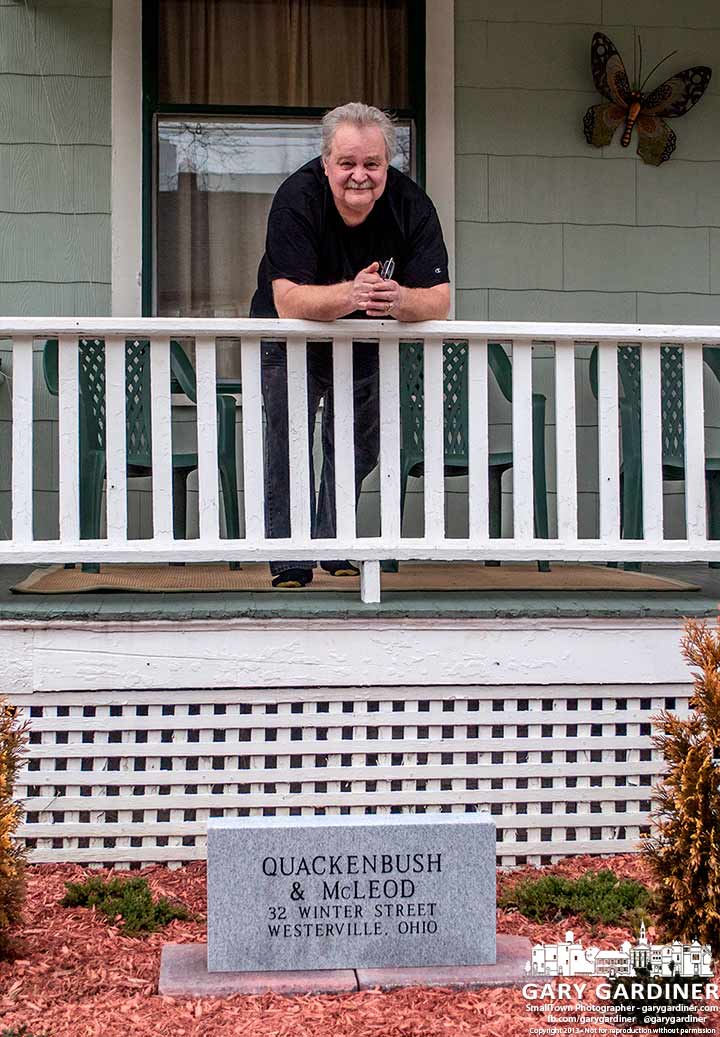
Honor Guard Honors Retired Officer
A Columbus Police Honor Guard officer carries a folded flag to present it to the family of a retired officer who was buried Thursday at Blendon Central Cemetery. My Final Photo for April 5, 2018.

A Columbus Police Honor Guard officer carries a folded flag to present it to the family of a retired officer who was buried Thursday at Blendon Central Cemetery. My Final Photo for April 5, 2018.


Earlier today one of my Facebook friends pointed me towards a New York Times story with a remarkable photo of a lone person walking through dust and debris in a canyon of buildings destroyed by the war in Syria.
I always enjoy our online conversations because each of us have strong opinions, don’t always agree, respect each other, and love photography.
Today we agreed that it’s very difficult for a photographer to express pride or contentment having to shoot photos like the one he pointed me to. It’s not an enjoyable task, shooting disasters and deaths.
I spent almost all of my photojournalism career shooting moments that weren’t necessarily very enjoyable. There’s plane crashes and auto wrecks. Funerals for police, firefighters, children, military, the famous and infamous.
The photo at right is one of those moments where journalism overcame emotion and fear in an attempt to communicate to newspaper readers the gravity of burying six children at the same time.
There were only three frames of film from this viewpoint. I’d left my other cameras with telephoto lenses in the car and walked up to the crowd of mourners carrying one camera with a wide-angle lens. I stood quietly at the edge of the crowd gathered tightly against the edge of the tent covering the families and the caskets. I stayed quiet, my camera concealed under my winter coat, until I could see through the space between the heads of several mourners that emotion had reached its zenith.
As the parents hugged and the pastors said the final prayers I reached over the crowd positioned my camera in where I hoped it would be a good angle and fired three frames. No motor drive. This was film days and cameras still had a thumb drive for moments just like this.
As soon as I shot the three frames I returned to my car and left.
I knew I had photos to help tell the anguish of a funeral for six children. Also, I didn’t want to explain my actions to anyone who was offended.
My actions were cold and calculated. I anticipated one of the reactions would be anger at me. Still, the story needed to be told. I am a photographer. I did what was needed to tell the story.
No one chased after me. No one complained. There were no nasty letters from readers.
I did receive congratulations for succeeding with a good photo in such a tough situation.
I thought of this photo when I had my Facebook conversation this morning. Especially after what had happened the night before.
One of my granddaughters visited last night wanting me to give her a bunch of black and white prints from my archive so she could decorate the walls of her room. Among her choices, in addition to the dogs, cats, and skunk photos, were photos of Jerry Rubin, Jane Fonda, Stokely Carmichael, a couple of presidents before Clinton, andassorted spot news photos. Sandwiched in the collection now covering her walls are old news photos showing disasters, insurrection, injury, and recovery.
All are now decoration for a teenager’s room. They are not even the poignant records of events forgotten in time except for the participants, and the photographers who were the observers.
They are decoration, wallpaper in black and white blurred to the grays of history.
At right is My Final Photo for Monday, April 8, 2013.
My wife sings in the funeral choir of our church where all too often she learns about other people’s lives and family too late to enjoy the living.
The eulogies are always gracious with friends and family speaking about the transitional moments in relationships, how their lives were changed by the relationship, and how sorrow becomes the catalyst that brings them all together to remember another’s life.
That was the situation several years ago when my mother-in-law died after battling heart problems. Her family gathered in the crisp cold of a North Dakota winter.
“Family had gathered to celebrate the gentleness of a woman whose tumultuous life never betrayed her love for her children. We stood together, in tears, not afraid to speak of the good things, the moments of congratulations and celebration bequeathed to her children. A gift to pass along to the following generations without condition or regret.
“Early winter’s fresh snow near the rock changed the landscape ever so briefly reminding me of that moment, when brothers and sisters, aunt, uncles, nieces and nephews gathered in a place to celebrate a life. We were in that moment of cold between death and resurrection when only memories brighten the day and tears wash away the sadness. It’s a shame it sometimes takes the bitterness of death for us to celebrate the good in people’s lives.” – From The Rock At Inniswood.
Several weeks ago one of the daughters mentioned on Facebook that it was the anniversary of her death and how much she was missed. Minutes later I’d uploaded a photo of the family gathered at the church after her funeral. Everyone stood close together, joined in grief and joy.
Several years ago the New York Times wrote about the elevation of obituary writers to lofty news writing icons. The task once detailed to the lowest of copy writers is now a much sought after job where style is measured beyond the ability to lace a linear timeline into a cohesive description of life passed.
My mother never trusted obituary writers, even the ones who wrote the succinct one-column catalogs only published in her local paper accompanied with a photo of an undetermined date to best illustrate the best day in their life.
She didn’t want her life’s catalog to omit anyone, any important event, and any family connection no matter the status. To make sure, she wrote her own obituary.
It’s difficult to say but she was fortunate that she knew death was coming. She’d survived an earlier fight against cancer but knew her second battle aggravated by a heart problem would not be one she’d win. She wasn’t eager to die but believed she’d soon be with my dad and that was all that mattered at the end.
Her obituary was perfect, completing a life of honor and dedication to family and friends.
During the discussion about obituaries with my wife she asked if, like my mother, I would write my own to make sure it was accurate and inclusive of all that mattered to me.
“My photography is my obituary,” was my answer.
The collection of all the 1/125th of a second frames, of all the spot news, sports, features, portraits, landscapes, and snapshots, would speak for me at my death. I’ve no idea how many photographs I’ve taken. Nor how many times I’ve pressed the shutter, watched as the screen went dark and then returned to brightness revealing the moment after the photo I didn’t see.
I’ll never know how many people have seen my photography. After more than 40 years shooting for newspapers and The AP there would be no way to know.
I do know about the lady behind my wife at the grocery store in Ft. Lauderdale who talked with another customer about my photos that were in the previous day’s newspaper.
I do know about the father who greeted me with his phone showing off the photos I’d taken of his son and hearing about how he will never delete them.
There are more stories than I can ever remember of people telling me about a photo I’d shot of them or a photo they saw published that they affected them.
Got that response from mothers and fathers, sons and daughters, police officer and firefighters, a president, several governors and many politicians, kids, criminals, and death row inmates.
The common thread for all of them was my photography. It spoke to them and was now registered in their memory. At the lower corner was the credit line “Photo by Gary Gardiner.”
One of the plans for my funeral is to continue My Final Photo until the cold earth is lowered over the casket.
I’ve arranged with friends to set up a camera in my casket as if I’d just pulled it from my eye so they can see my final pose. As each passes the casket the camera will shoot a frame and deliver it to the My Final Photo Web site. My obituary, at least my obituary of photos, will continue after my traditional obituary is printed in the local paper.
Every day, as I prepare myself for the task of creating another photo for the My Final Photo project, I want to be sure, if it is indeed my last photo, that it is memorable. That it is storytelling and evocative. That it contributes to the story of my life in some way that others might be interested in vying to be the writer and photo editor for the New York Times who will tell my story.
My son-in-law says my tombstone should read:
Her Lies Gary Gardiner – Photographer
“Pretend I’m Not Here”
That may be the perfect obituary for a photographer.

 There’s a good reason for the granite monument in the front yard of this home on Winter Street. The owner, whose family has lived in the home for several generations installed the slab to commemorate the Quackenbush and McLeod families who have lived in the house.
There’s a good reason for the granite monument in the front yard of this home on Winter Street. The owner, whose family has lived in the home for several generations installed the slab to commemorate the Quackenbush and McLeod families who have lived in the house.
Not a lot more to tell unless you want to stop by and hear the story for yourself.